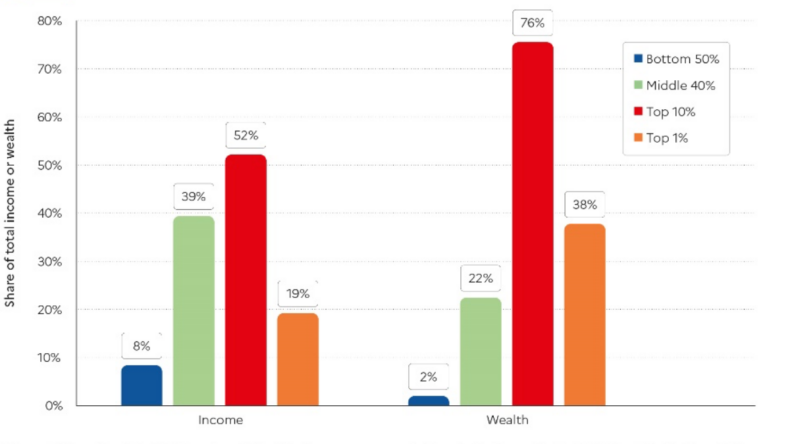As unfortunate anticipation, the World Inequality Report, 2022 is a database of sad truth. The report depicts and analyses the global inequality trends, further segregating them nation wise.
The inequality data report inculcates gender, environmental and tax justification aspects. The data is a neat representation of high disparities between the poorest and the wealthiest global adult population in terms of global wealth and global income.
The report depicts numerical data and factors leading to a benchmark of inequality. It also provides an insight into societal structures promoting income inequality.
India’s data analysis showcases its bitter polar side – soaring inequality and poverty. The socio-political scenario of India demonstrated a more detailed look at the factors caused by this democracy, leading to huge disparities.
The Income Imbalance
In the context of economics, income is capital earned by individuals on a day-to-day or regular basis, whereas wealth is the gross or total value in terms of possessions and money owned.
The World Inequality Report provides that 50% of the bottom global adult population shares 2% of global wealth. At the same time, the top-most or the wealthiest 0.001% (51,700 adults) own 6.4% of global wealth.
India, with a population of 1.39 billion (in 2021), has experienced noticeable income inequality. The middle class is seen succumbing to inflation, falling prey to poverty at a decent speed.
In contrast, the income and investments of the more affluent half have escalated at an impractical pace. While the latter’s earning has increased twenty times than the bottom half.
The report also clarifies the decreased transparency and reliability of data provided by governments and other organizations all around.
The report mentions the increased opacity of inequality data affecting the quality of analysis. Further, the exact causes difficulties in comprehending the developments concerning inequality.
Democratic Inequality
India’s socio-political and economic circumstances have pushed half of the population into poverty. Despite being a democracy claiming to be a socialist nation, the polarising politics through decades has welcomed globalization and privatization without hesitation.
The past few years have seen a warm welcome of crony capitalism. With the private sector having the upper hand over political parties and eventually the political ground, the social circumstances have transformed accordingly.
Furthermore, the economic potential of India has been wasted through public policy favouring the private sectors. The politically sponsored inflation has fed poverty to more than half of the Indian population while the income of the rich has swollen.
The bottom group owns almost nothing with no choice to invest. The middle class is left with minimal options to invest in for future purposes. On the contrary, the wealthier population has no demarcations.
With all doors open towards investing, the wealthier strata seek profits. The development of poverty has also created a more affluent and elite class.
Private wealth has reached a sky-high in developing nations owing to the accelerated privatization. As mentioned, crony capitalism has resulted in the public sector’s wealth being stagnant or deteriorating.
Besides this, as the pandemic added to the adversity of the poor, it profited the wealthy like never before. The unemployment, inflation, crumbling infrastructures and unaccountability of the government intensified the repercussions.
Contributors to the soaring wealth of the affluent
The tremendous growth in wealth inequality is a result of a capitalistic and political partnership aiming at more profits from the pockets of the poor—more apparent than ever, distinctions among classes based on financial and social status.
The affluent and elite group is aware of its authority due to its overflowing treasury. Thus, it focuses on expanding the polarity between the rich and poor through unequal changes.
The affluent groups know that the influence over politics and society is a result of increased inequality, promote it in shadow. This class is highly against the concept of taxing the rich as it affects their economic status and then their power.
If the rates of inequality continue to spike, then the wealth gaps are anticipated to only expand. Unless the political authorities do not wish to, the disparity will experience a rising graph in the coming decades.
The approach of governments directly impacts the status and transformation of graphs of inequality. Inequality is ubiquitous, with varying gaps globally and nationally. Redistribution of wealth and reforms in the capitalist taxation structures are critical factors in reducing the gap.
Inequality is not just inevitable but also politically sponsored. Unless the power groups wish to share their money equally with others, a reduction in prevalent income differences looks like a dream. The other way out of the disparities is a revolution by the have-nots with crusading mindsets.













